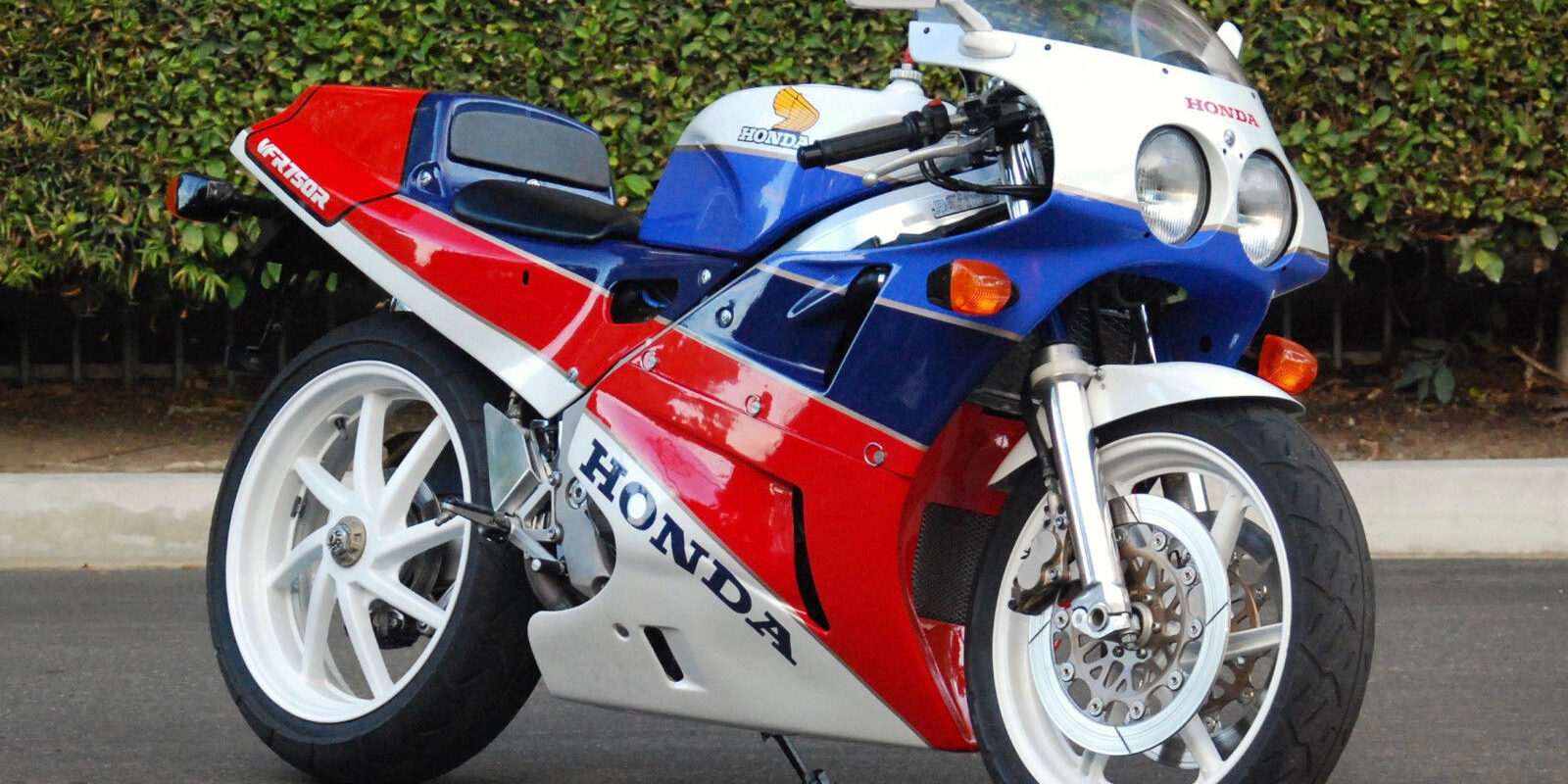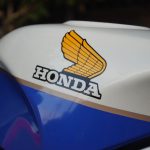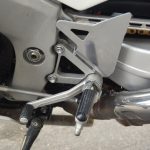Long before “mass centralization” became a popular marketing buzzword for sportbikes, Honda was investing its bubble economy-inflated budget in a bike that took advantage of that very concept, the exquisitely-engineered VFR750R, otherwise known as the legendary RC30. Honda was so invested in sportbikes at the time that it actually sold an I4 and a V4 range of bikes concurrently, with their CBR and VFR filling slightly different niches. But when it came to their homologation bikes, Honda took their hard-won knowledge from the street-oriented V4 bikes and used it to develop the bike seen here, the VFR750R.
If you’re passingly familiar with Honda’s roadbikes, “VFR” probably evokes images of practical and engaging sport-touring bikes that lean on the sport end of the spectrum. This is not one of those bikes. The RC30 was developed to win production-based racing classes, specifically the then-new World Superbike Championship, although the ELF-designed single-sided swingarm hints at the bike’s endurance racing capabilities as well.
At the heart of the bike is obviously a compact V4 engine with a relatively narrow frontal area for good aerodynamics and very centralized mass, gear-driven cams for extremely precise valve control, and a 360°crankshaft that improved traction at the rear wheel, compared to a more traditional 180° unit. The concept of the 360° crank is that the combustion events are clustered close together, instead of spaced evenly throughout each engine revolution to allow the rear tire to “recover,” increasing traction and improving tire life. It also gives the bike a flatter powerband and a distinctive soundtrack that can be appreciated, even if your skills don’t extend to tire-spinning corner exits. The downside of a V4 is generally increased weight compared to an inline-four and tight packaging, especially with a 90° v-angle, as used here. Stripped of its fairing, the RC30 looks very dense and packed with mechanical bits, and V4s can be a bit of a bear to work on.
Reviews then and now describe it as an easy bike to take full advantage of, a bike that rewarded finesse, a bike that just did as it was told and allowed the rider to get on with winning. Power was unremarkable, weight was average, and nothing about the bike screamed “race winner.” But win it did, even against stiff opposition from Ducati, Bimota, Suzuki, Yamaha, and Kawasaki, and Honda only abandoned the V4 formula when it decided that rules in WSBK favoring v-twins were onerous and biased. So they built a v-twin and showed everyone they could win with those as well, but it was clear their hearts would always belong to the V4…
The RC30 is a handsome bike, with nearly perfect proportions and a wealth of amazing details, although it doesn’t have the easy wow-factor of something from Italy. It’s not often you can accuse Ducati of cribbing styling elements, but the 916’s taillights and distinctive single-sided swingarm look awfully similar to what you can see here. And unlike those Italian machines, every single component is carefully thought out to work as part of a complete package, and engineered to near-perfection.
From the original eBay listing: 1989 Honda VFR750R RC30 for Sale
- Long term ownership and fewer than 5,000 miles
- 1989 Honda VFR750R RC30
- Frame Number: 2100129
- Engine Number: 2100162
- Legendary 16-valve gear-driven DOHC 90 degree V4 engine
- Reportedly fewer than 3000 produced
- Single owner since 1990
- Fewer than 5,000 miles from new.
One of the modern era’s few immediately collectible classics, the Honda VFR750R – better known as the ‘RC30′ – was created for just one reason: to win the World Superbike Championship, a feat it achieved in the nascent series’ first two seasons of 1988 and 1989. And while American Fred Merkel was bringing Honda its first two WSB crowns, Britain’s Carl Fogarty used an RC30 to win the TT F1 World Championship in 1988 and 1989, and the equivalent FIM Cup in 1990. No mere short circuit scratcher, the RC30 and its derivatives proved durable enough to win a hat-full of Endurance Classics too. That this latter requirement was also part of the design brief may be determined from the fact that a quick-release front fork and single-sided swinging arm – essential for speedy wheel changes – were part of an unrivaled specification that included a twin-spar alloy beam frame, 16-valve V4 engine with gear-driven cams, close-ratio six-speed gearbox and four-pot front brake calipers.
All of which did not come cheap: at the time of its launch in 1988 an RC30 cost near double that of other super-sports 750s. Despite the passage of time and progress of motorcycle technology, the RC30 remains a match for the latest generation of sports bikes but possesses an exclusivity that none of them can approach. ‘No other bike from the late-Eighties is lusted after like the RC30’, reckoned Bike, and few would disagree. And then there’s the exhaust note – loud, of course, but soulful enough to bring a pit crew to tears.
This RC30 was only very recently liberated from its second and very long-term owner. Purchased in the UK in 1990, fewer than 5,000 miles have been put on the bike since it was new. Not long after acquisition, the superbike was taken to the Isle of Man where it was driven around the race track, but not actually raced. In 1991 the machine was brought stateside. Regularly maintained since new, the previous owner reports that the RC30 was taken to the local Honda dealer for a pre-sale service within the last couple of months.
Fresh from nearly three decades of single owner care, this legendary machine is offered in excellent condition throughout. The engine starts readily, idles smoothly and has an abundance of power. The clutch is silky-smooth and brakes and suspension are near perfect. I would opt for a new pair of tires before serious road use and am happy to negotiate your tire choice in to the price.
This is a rare opportunity to acquire a motorcycling icon of performance and provenance and a must-have for a discerning collection.
For additional information and photos go to ClassicAvenue.com
V4s are all the rage these days, but Honda really pioneered them for modern motorcycle applications. Because who the hell else would want to design around such a packaging headache? Obviously, Honda has a history of doing things just because they can, practicality be damned: their oval-pistoned racebikes grew out of a staunch refusal to adapt to the changing technology of the Grand Prix scene and simply build a competitive two-stroke. And although that particular experiment was a failure, it shows the lengths to which Honda will go when they believe in an engineering concept. Luckily, the V4 wasn’t quite so complex and was ultimately vindicated by both in-period success and by the legacy it left behind. This example has very low miles and appears to be in very nice, original condition with an asking price of $44,900 and just one more day on the listing, so if you didn’t get what you wanted for Christmas this year and happen to have a bit of your holiday bonus left lying around…
-tad




















Looks like a couple hours with some soap and a toothbrush would make this bike much more presentable
To someone who hasn’t owned a few of these, this looks pretty good at first glance. Tad, please allow me to point out a few things that jump out at me as incorrect. But first, $45,000 asking price but not even a single picture showing what’s underneath the bodywork? Impossible to really assess condition without that. Is that unique RC30 tool kit roll there? What are the corrosion levels on the aluminum and magnesium parts? Where’s the rear wheel stand that came in the crate with every RC30? If that tool kit and stand are not included, figure at least $1K to find them both, and good luck.
Details I notice:
1.) seat back pad is not original and wrong- way too thin.
2.) missing fork rebound and compression damping adjustment ring stickers. They’re available.
3.) missing left lower fairing attachment to frame bracket, by the shift linkage. Has something else in place, fairing is just hanging in the air at that point.
4.) sloppy job refinishing the fork legs: over polished, and they even left the corrosion on upper dust seal areas and lower quick release clamps.
5.) what’s going on with the VIN plate being creased, wrinkled, and coming off the right frame spar?
6.) evidence of re-spray: left upper fairing missing two small plastic pins, and their holes, that hold missing rubber flap over radiator hose.
7.) further evidence: lower fairing radiator screen behind front wheel has two attachment rivets painted over.
Am being I nit picky? Guilty. But those are some details that help point out actual existing condition and raise questions. This is an iconic, expensive machine and buyers need to look very closely to try to determine condition and value.
SixthGear, no problem at all. That’s the kind of polite commentary and expert input we appreciate, and includes plenty of specific details. Given the asking price, potential buyers should be aware of these issues so they can decide for themselves if they’re a problem or not. Thanks for your support of the site!
I’m amazed at all the knowledge this site up brings!!!! Merry Christmas too all. This site is absolutely amazing! I consider myself pretty intelligent but some facts that get brought up here are unreal. Best site on the internet by FAR!!!!!!!
This very same bike was just purchased at the Barber Museum auction a few months ago. If you do a search at the Barber/Bonhams auction in Oct 2018, it sold for $27K including premium. Talk about a profitable flip, the Buyer stole this bike at 27000. Goes to show you how you can’t trust these auction houses that won’t allow you to set your reserve very high, Bonhams and Mecum both, greedy bastards and they take 15% so the seller netted what, 23K or so? I bet the original seller is livid, I would be. $27K for a low mileage RC30, what a pick up! Good luck on the sale, nice bike.
I love it when the detail inclined knowledgeable folks share their insights. Merry Xmas RSBFS!
I ask myself why a seller would poorly represent such a bike with a $50k asking price. The glaring lack of detail, naked photos or VIN numbers clouds the provenance. Further, the seller claims clear title, yet I doubt it is registered in California (where the dealer is located) or elsewhere. Sad.
A bit of a general question to all – would you personally prefer the large headlights of the export model, or smaller headlights of the JDM version?
If anyone needs a new RC30 wiring harness, uncut stock rear fender and toolkit, I have all 3.
I got them in the early 1990s when I was going to buy a lightly used UK ex-race bike RC30. The deal ultimately fell through.
I am just guessing here, but maybe this bike served the 1989 season as either a road race track marshal bike or as a backup race bike – and that explains some of the little things.
Some of the lightly raced and backup race UK 88 and 89 bikes cleaned up pretty well and where sold to a few eagerly awaiting US buyers – since even though Honda mass produced the RC30 for the US market (300), they seemed to be hard to liberate from dealers at retail price if you did not get on the pre-order band wagon.
I also recall more than a few spare RC30 tail pieces sold back over the water to displace the boring VFR750R tail pieces that other markets received.
I also had one such NOS RC30 tail piece as well – sold it to someone here in the US for about $1500 back in 1998.
Rc45. I could really use a fender but I’d be in the market for all 3 if all three are available. Finishing up a RC30 restoration for a client right now and need a fender. The rest of the parts I may need for the other bikes were building. I met the seller of this particular RC30. Nice guy! Im at adamt@iconicmotorbikes.com. Happy holidays everyone!
While I really enjoy seeing bikes like this that are now up for sale, the moment that I see that the bike is being sold by a flipper, the bike loses a lot of it’s appeal. Original ownership, or long term ownership, just adds that extra something that makes the bike more desirable. Do others feel this way too?
@SixthGear – I paid $1500 retail for my RC45 stand, same part number as the RC30 stand in 1999. The RC30 tool kit used to retail for $600 for the main one and $200 for the sub kit.
So I would budget closer to $2500 for perfect new items – assuming one is satisfied with recovering retail in the sale. I could see a person with a new RC30/45 stand trying to get $3000 or more for it LOL.
I am still spinning in circles at the insane idea of bringing a machine of this level to a dealership for a pre-sale service. Here in New York, a sin like that would bring the asking price down about 10K. I wonder what snot nosed millennial know-it-all got his inexperienced hands on it only to strip a few bolts, break a few fasteners, lose some valuable hardware that he seems to think is no big to replace with china junk, and of course some nicely placed scratches here and there for sure joined by a broken tab or two. Sorry for the negativity folks, but it is a crying shame to think this incredible machine was brought to a local honda dealer to have it’s value diminished be for it is flipped. I agree with 2manyprjx .I may have considered a puchase here had it been from the long term collector before. Makes me sad and a bit angry too.
@RC45- my pricing on those missing items was from previous used parts pricing, but I’m not surprised at current new market values. This is one reason why I no longer undertake RC30 restorations, and only assist in them at this point. I highly doubt those things are included with this example, and what are the chances that everything is in place, correct, and undamaged underneath the bodywork? Guess the buyer will find out, and have some surprises. Given the now revealed recent history of this one, and what we can see on the outside, I would be patient and wait for the right example. I hope that we’ve educated some collectors currently looking for their first one.
My fist question when considering a motorcycle on ebay, ” How long have you owned this motorcycle and how many miles have you ridden it?” I also avoid “flippers”.
RC45 – I’m interested in the RC30 toolkit. Is it still available? What’s the best way to get in contact? Thanks.
Rc45, I do have a beautiful RC30 stand that I will be looking to sell, just winder what should I settle for??
Gary, a nice OEM RC30 stand sold on eBay recently for a little over $600.
There’s a decent rear fender on eBay right now with no reserve. There’s a good Facebook page for buying/selling RC30/45 bikes/parts, most members are in Europe but I’ve had good luck picking up some things I needed, seems like a good group of guys and very knowledgeable.
I agree this isn’t a $40k bike. If it’s all good under the bodywork, the buyer did well at the $27k he paid at Barber though. With current prices this one seems like it should sell in the low $30k range.